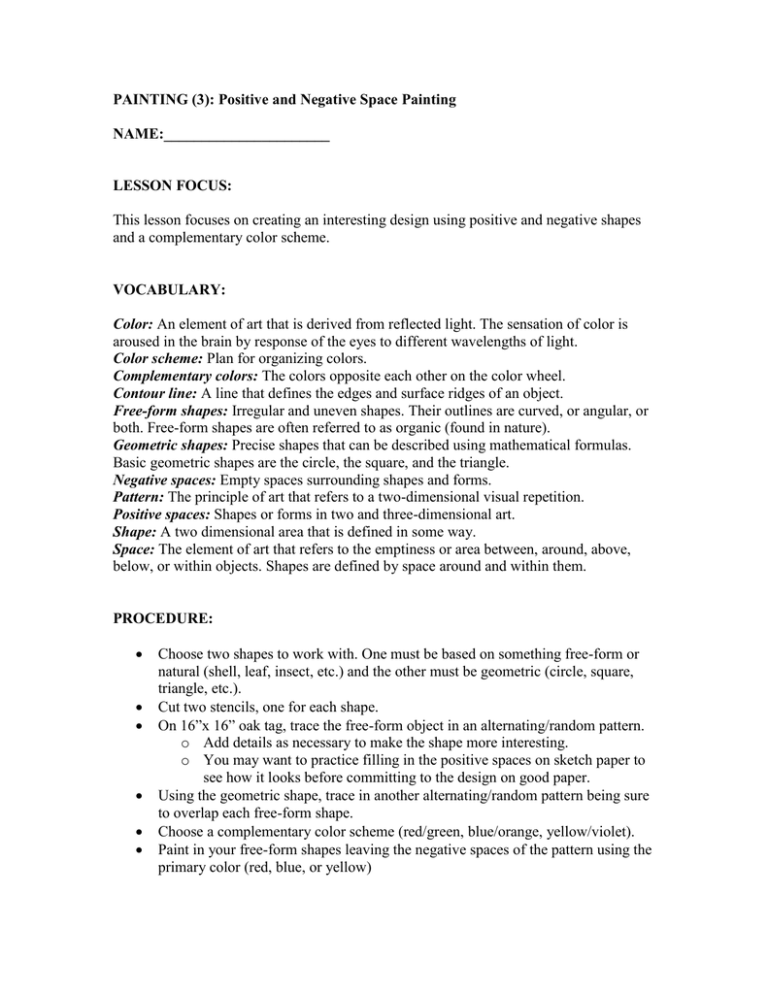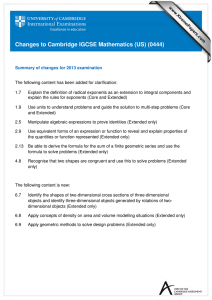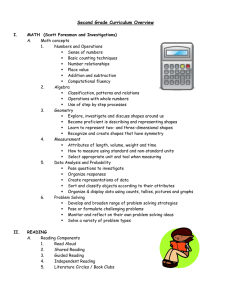PAINTING (3): Positive and Negative Space Painting NAME:______________________ LESSON FOCUS:
advertisement

PAINTING (3): Positive and Negative Space Painting NAME:______________________ LESSON FOCUS: This lesson focuses on creating an interesting design using positive and negative shapes and a complementary color scheme. VOCABULARY: Color: An element of art that is derived from reflected light. The sensation of color is aroused in the brain by response of the eyes to different wavelengths of light. Color scheme: Plan for organizing colors. Complementary colors: The colors opposite each other on the color wheel. Contour line: A line that defines the edges and surface ridges of an object. Free-form shapes: Irregular and uneven shapes. Their outlines are curved, or angular, or both. Free-form shapes are often referred to as organic (found in nature). Geometric shapes: Precise shapes that can be described using mathematical formulas. Basic geometric shapes are the circle, the square, and the triangle. Negative spaces: Empty spaces surrounding shapes and forms. Pattern: The principle of art that refers to a two-dimensional visual repetition. Positive spaces: Shapes or forms in two and three-dimensional art. Shape: A two dimensional area that is defined in some way. Space: The element of art that refers to the emptiness or area between, around, above, below, or within objects. Shapes are defined by space around and within them. PROCEDURE: Choose two shapes to work with. One must be based on something free-form or natural (shell, leaf, insect, etc.) and the other must be geometric (circle, square, triangle, etc.). Cut two stencils, one for each shape. On 16”x 16” oak tag, trace the free-form object in an alternating/random pattern. o Add details as necessary to make the shape more interesting. o You may want to practice filling in the positive spaces on sketch paper to see how it looks before committing to the design on good paper. Using the geometric shape, trace in another alternating/random pattern being sure to overlap each free-form shape. Choose a complementary color scheme (red/green, blue/orange, yellow/violet). Paint in your free-form shapes leaving the negative spaces of the pattern using the primary color (red, blue, or yellow) All areas INSIDE the geometric shapes should be colored in using the primary color (red, yellow, or blue). All negative spaces and the shapes created by overlapping, will be painted using the complement of your primary color (green, orange, or violet). MATERIALS: 16”x 16” manila sketch paper 16”x 16” oak tag Oak tag for stencils Pencil and eraser for sketches Tempera paint Brushes







